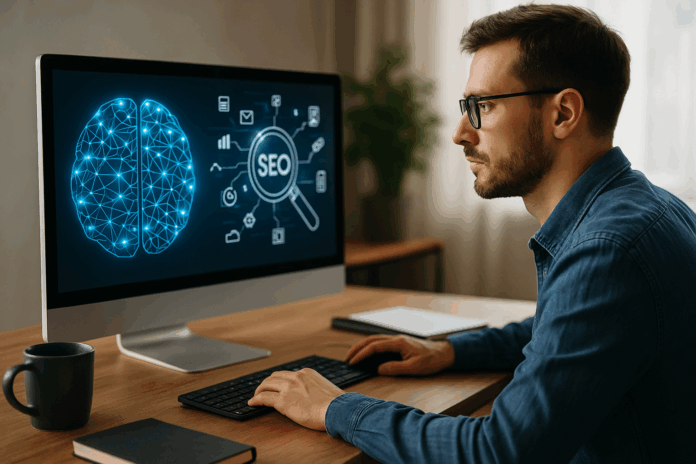SEO used to be about links, keywords, and a sprinkle of meta descriptions. Then mobile-first indexing came along. Now? It’s not even about rankings anymore, but not in the traditional way we think about them.
With AI platforms like ChatGPT, Google Gemini, and Perplexity reshaping how people search, your content needs to do more than rank. It needs to be understood by AI, summarized by AI, and ideally cited by AI.
For brands and content creators, this shift means visibility is no longer just about ranking high in search results. It means leveraging SEO activities to continue to inform search bots (whether traditional web crawlers or now, AI system) about the content and purpose of your site. As artificial intelligence (AI) becomes the backbone of modern search engines, the relationship between AI and SEO is evolving into a strategic partnership that companies (large and small) can’t afford to ignore.
In this new landscape, SEO isn’t just a backend checklist. Now, technical SEO provides the language that helps AI interpret your site’s purpose, credibility, and relevance. This isn’t about choosing between AI or SEO. It’s about understanding how AI and SEO work together, and how modern marketers and brands use both to stay visible, relevant, and competitive.
How Technical SEO Informs AI Robots

AI models, like the ones that power AI Overviews (AIOs), require well-structured, clear information. Technical SEO is the key to feeding them. Fortunately, at its core, technical SEO is about making content discoverable and easier for machines (or bots) to read and understand. Likewise, AI is about simplifying content or complex ideas understandable for consumers. When these two forces work together, they unlock powerful opportunities for brands to be found, featured, and favored in search results.
Here’s how AI and SEO intersect:
- Semantic Search & Natural Language Processing (NLP): AI enables search engines to understand user intent beyond exact-match keywords. SEO must now optimize for meaning, not just phrasing.
- AIOs & Answer Engines: Platforms like Google SGE, Bing Copilot, and Perplexity use AI to generate summaries and answers. SEO teams must create content that’s not only informative but also citation-worthy for these systems.
- Technical SEO as AI Guidance: Structured data, schema markup, and metadata act as signals that guide AI in interpreting page content. Without them, even great content can be invisible to intelligent crawlers.
- Content Monitoring in AI Outputs: As AI platforms increasingly reference third-party content, brands need tools and strategies to monitor where and how their content appears.
- Evolving Ranking Signals: AI evaluates trust, authority, freshness, and user engagement (whereas SEO primarily revolves around producing keyword specific content). SEO must evolve to meet these multidimensional criteria.
Together, AI and SEO are redefining what it means to be “searchable.” It’s no longer enough to optimize for algorithms, you must optimize for understanding.
How to Speak AI’s Language

Before large language models took over our SERPs, SEO generally focused on crawlable pages, clean markup, and the right keywords in the right spots. But now, if your content doesn’t speak AI’s language, it may as well be invisible. From structured data to site architecture, utilizing “behind the scenes” SEO signals helps speak AI’s language.
Structured data (schema.org) helps AI understand content relationships
Schema.org markup is a type of structured data that helps AI crawlers understand the context of your content. Think of schema as structured subtitles for your website. It’s how you explain to machines, “Hey, this is a product page” or “This is an FAQ.” Without it, AI is guessing.
Actionable Tip: Getting Started with Schema Markup
- Identify relevant schema types: Use the Schema.org vocabulary to find the markup that best describes your content (e.g., Article, FAQPage, Product).
- Implement schema using JSON-LD: This is the recommended format. You can manually create the code or use a schema markup generator tool.
- Test your markup: Use Google’s Rich Results Test to ensure your schema is implemented correctly and eligible for rich results and potentially AIOs.
- Monitor performance: Check Google Search Console’s enhancements reports to see if Google has detected and understood your schema markup.
Logical Content Structure and Internal Linking
A clear content hierarchy, defined by headings (H1, H2, etc.), and a strong internal linking strategy show AI systems the relationships between your content. This helps them recognize your site as a comprehensive, authoritative source on a given topic, increasing the likelihood of your content being featured in an AI summary.
Actionable Tip: Optimizing Content Structure and Internal Linking
- Use headings correctly: Structure your content logically with a single H1, followed by H2s, H3s, and so on.
- Create comprehensive content clusters: Group related content around pillar pages and link extensively between them.
- Use descriptive anchor text: The text you use to link internally should clearly indicate the content of the linked page.
- Audit your internal links: Regularly check for broken or irrelevant internal links.
Content Strategy Meets AI

The new challenge for SEO professionals is to monitor not just rankings, but also whether their content is appearing in AIOs. Previously, SEO content strategy revolved around specific content for individual keywords (or clusters) that demonstrated authenticity and generated backlinks. With AI, then the focus on authenticity and expertise remains, but the models also analyze intent and context, which require a more nuanced content strategy. During the next content analysis, look to refresh old content with AI friendly updates (as outlined below), but also review the structure and internal links.
The Shift to Experience and Trust (E-E-A-T)
As AI generates more content, human-created content that demonstrates Experience, Expertise, Authoritativeness, and Trustworthiness (E-E-A-T) becomes even more valuable. AI cannot replicate unique insights, personal stories, and firsthand data. As a result, embracing the human element helps generate content that not only increases the chances of being deemed relevant in AIOs, but more importantly, also helps readers!
Actionable Tip: Emphasizing E-E-A-T
- Showcase expertise: Clearly highlight the authors’ credentials and expertise on the topics they cover.
- Share experiences: Include personal anecdotes, case studies, and unique data that demonstrates firsthand experience.
- Build authority: Earn high-quality backlinks from reputable sources and ensure your content is accurate and well-researched.
- Foster trust: Have clear “About Us” and “Contact Us” pages, transparent policies, and ensure your website is secure (HTTPS).
Generative AI for Content Creation
Many SEOs are using AI tools to assist in content creation, from keyword research and outline generation to drafting first versions of articles. The most effective strategy is to use AI for efficiency and then have a human writer add the unique value, personality, and expertise that only a person can provide.
Actionable Tip: Integrating AI into Your Content Workflow
- Experiment with AI writing tools: Explore different AI writing assistants to see how they can help with tasks like brainstorming, outlining, or drafting initial content.
- Focus on editing and enhancing: Always have a human editor review and significantly enhance AI-generated content to ensure accuracy, originality, and alignment with your brand voice.
- Use AI for repetitive tasks: Leverage AI for tasks like summarizing information, transcribing audio, or generating social media posts based on your core content.
Tracking and Reporting
Traditional SEO tools are adapting to include metrics that show if a query is triggering an AIO and if your site is a cited source. Previously, a rise in organic search rankings meant an increase in clicks. Now, AIOs synthesize the content from the top search results, which reduces visibility and traffic. As tracking and reporting evolves, look for tools that capture visibility in these new search features.
Actionable Tip: Monitoring AI Overview Presence
- Research keywords triggering AIOs: Use your keyword research tools to identify search terms in your niche that commonly display AIOs.
- Manually check search results: Regularly perform searches for your target keywords to see if AIOs are appearing and if your site is cited.
- Set up forum alerts: Create notifications for various brand mentions and URL appearances across popular forums popular that inform AIOs (such as Reddit and Quora).
- Explore new SEO tools: Look for SEO platforms that are actively developing features to track AIO performance and citations. Marketers must track AI exposure, visibility in zero-click searches, and how AI tools (like ChatGPT or Perplexity) reference brand content, so finding the right tools to capture this data is paramount to success.
- Analyze traffic patterns: Look for increases in organic traffic to pages that are likely being cited in AIOs. Additionally, watch for referral traffic from AI bots, ChatGPT plug-ins, or embedded browser tools.
Leveraging Google Search Console
Google’s own tools, like Search Console, may report on traffic from AIOs within the “Web” search type. Clicks from AI-generated results are often ‘higher quality,’ as users are typically seeking very specific information and are more likely to engage with the relevant content once they arrive on the site.
Actionable Tip: Using Google Search Console for AI Insights
- Navigate to the Performance report: In Google Search Console, go to “Performance” and filter by “Search appearance.”
- Look for “AI Overview”: While not always explicitly labeled yet, keep an eye out for new filter options or changes in how clicks and impressions are reported that might indicate AIO traffic within the “Web” search type.
- Analyze landing pages: Identify which of your pages are receiving clicks after an AIO and analyze why they might be preferred by the AI.
AI and SEO Are Not Opposites

AI is changing how search works, but not what makes SEO effective. Technical best practices, authoritative content, and brand trust still matter. The difference is that now, you must optimize not just for humans or search bots, but also for AI agents summarizing and ranking your content behind the scenes.
SEO professionals and digital marketers who embrace AI will be better equipped to win the next evolution of search. To get started, think about manual tasks that basically scrap information from the internet and look to automate them. For example, embrace automation for things like:
- Content briefs
- Title/meta optimization
- Competitor benchmarking
- Predictive modeling
By embracing the AI age, marketers and brands can adopt a generative engine optimization (GEO) mindset and start moving to where the puck is headed. GEO isn’t about gaming AI, rather providing clean, useful, structured signals that makes summarizing your content easy. The easier you make it for AI, the more likely you are to show up in those coveted overviews.
Actionable Tip: Practicing Generative Engine Optimization
- Answer questions directly: Structure your content to directly answer specific questions that users are likely to ask.
- Use concise language: Avoid jargon and write in a clear, easy-to-understand style.
- Structure content for easy scanning: Use bullet points, numbered lists, and short paragraphs to make your content easily digestible for both humans and AI.
- Include key information upfront: Place the most important details at the beginning of your content or within the first paragraph.
- Build AI assisted workflows: With tools like ChatGPT + Sheets, Zapier, and Google Looker Studio, things that were manual in the past are now scalable and insight-driven.
The integration of AI into the search landscape presents both challenges and opportunities for SEO professionals. By understanding how AI systems work and adapting your strategies accordingly, you can ensure your content remains visible and valuable in this evolving digital world. Embracing technical SEO best practices, actively monitoring AIOs, and staying ahead of emerging trends will be crucial for long-term success in the age of AI.





